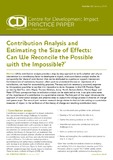Contribution Analysis and Estimating the Size of Effects: Can We Reconcile the Possible with the Impossible?
| dc.contributor.author | Ton, Giel | |
| dc.contributor.author | Mayne, John | |
| dc.contributor.author | Delahais, Thomas | |
| dc.contributor.author | Morell, Jonny | |
| dc.contributor.author | Befani, Barbara | |
| dc.contributor.author | Apgar, Marina | |
| dc.contributor.author | O’Flynn, Peter | |
| dc.date.accessioned | 2019-01-07T13:47:53Z | |
| dc.date.available | 2019-01-07T13:47:53Z | |
| dc.date.issued | 2019-01-07 | |
| dc.identifier.citation | Ton, G.; Mayne, J.; Delahais, T.; Morell, J.; Befani, B.; Apgar, M. and O'Flynn, P. (2019) Contribution Analysis and Estimating the Size of Effects: Can We Reconcile the Possible with the Impossible?, CDI Practice Paper 20, Brighton: IDS | en |
| dc.identifier.issn | 2053-0536 | |
| dc.identifier.uri | https://opendocs.ids.ac.uk/opendocs/handle/20.500.12413/14235 | |
| dc.description.abstract | While contribution analysis provides a step-by-step approach to verify whether and why an intervention is a contributory factor to development impact, most contribution analysis studies do not quantify the ‘share of contribution’ that can be attributed to a particular support intervention. Commissioners of evaluations, however, often want to understand the size or importance of a contribution, not least for accountability purposes. The easy (and not necessarily incorrect) response to this question would be to say that it is impossible to do so. However, in this CDI Practice Paper written by Giel Ton, John Mayne, Thomas Delahais, Jonny Morell, Barbara Befani, Marina Apgar and Peter O’Flynn, we explore how contribution analysis can be stretched so that it can give some sense of the importance of a contribution in a quantitative manner. The first part of the paper introduces the approach of contribution analysis and presents ideas to capture the change process in theories of change and system maps. The second part presents research design elements that include ranking or quantitative measures of impact in the verification of the theory of change and resulting contribution story. | en |
| dc.language.iso | en | en |
| dc.publisher | IDS | en |
| dc.relation.ispartofseries | CDI Practice Paper;20 | |
| dc.rights | This is an Open Access paper distributed under the terms of the Creative Commons Attribution Non Commercial 4.0 International licence (CC BY-NC), which permits use, distribution and reproduction in any medium, provided the original authors and source are credited, any modifications or adaptations are indicated, and the work is not used for commercial purposes. http://creativecommons.org/licenses/by-nc/4.0/legalcode | en |
| dc.rights.uri | http://creativecommons.org/licenses/by-nc/4.0/ | en |
| dc.subject | Finance | en |
| dc.title | Contribution Analysis and Estimating the Size of Effects: Can We Reconcile the Possible with the Impossible? | en |
| dc.type | CDI Practice Paper | en |
| dc.rights.holder | IDS | en |
| rioxxterms.funder | Default funder | en |
| rioxxterms.identifier.project | Default project | en |
| rioxxterms.version | VoR | en |
| rioxxterms.funder.project | 9ce4e4dc-26e9-4d78-96e9-15e4dcac0642 | en |
Files in this item
This item appears in the following Collection(s)
-
IDS Research [1661]
Except where otherwise noted, this item's license is described as This is an Open Access paper distributed under the terms of the Creative Commons Attribution Non Commercial 4.0 International licence (CC BY-NC), which permits use, distribution and reproduction in any medium, provided the original authors and source are credited, any modifications or adaptations are indicated, and the work is not used for commercial purposes.
http://creativecommons.org/licenses/by-nc/4.0/legalcode


